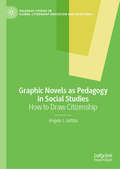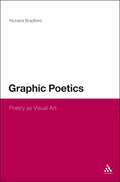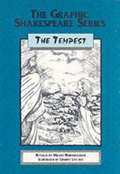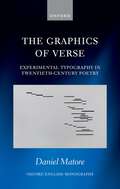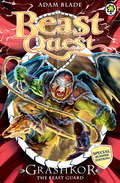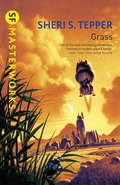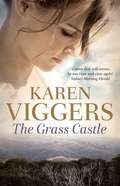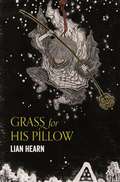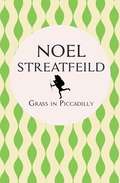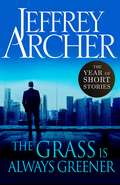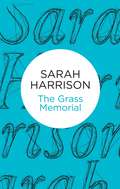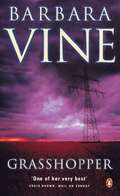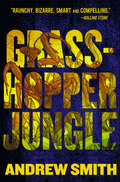- Table View
- List View
Graphic Novels and Comics as World Literature (Literatures as World Literature)
by James HodappGraphic narratives are one of the world's great art forms, but graphic novels and comics from Europe and the United States dominate scholarly conversations about them. Building upon the little extant scholarship on graphic narratives from the Global South, this collection moves beyond a narrow Western approach to this quickly expanding field. By focusing on texts from the Middle East, Africa, Latin America, and Asia, these essays expand the study of graphic narratives to a global scale. Graphic Novels and Comics as World Literature is also interested in how these texts engage with, fit in with, or complicate notions of World Literature. The larger theoretical framework of World Literature is joined with the postcolonial, decolonial, Global South, and similar approaches that argue explicitly or implicitly for the viability of non-Western graphic narratives on their own terms. Ultimately, this collection explores the ways that the unique formal qualities of graphic narratives from the Global South intersect with issues facing the study of international literatures, such as translation, commodification, circulation, Orientalism, and many others.
Graphic Novels and Comics as World Literature (Literatures as World Literature)
Graphic narratives are one of the world's great art forms, but graphic novels and comics from Europe and the United States dominate scholarly conversations about them. Building upon the little extant scholarship on graphic narratives from the Global South, this collection moves beyond a narrow Western approach to this quickly expanding field. By focusing on texts from the Middle East, Africa, Latin America, and Asia, these essays expand the study of graphic narratives to a global scale. Graphic Novels and Comics as World Literature is also interested in how these texts engage with, fit in with, or complicate notions of World Literature. The larger theoretical framework of World Literature is joined with the postcolonial, decolonial, Global South, and similar approaches that argue explicitly or implicitly for the viability of non-Western graphic narratives on their own terms. Ultimately, this collection explores the ways that the unique formal qualities of graphic narratives from the Global South intersect with issues facing the study of international literatures, such as translation, commodification, circulation, Orientalism, and many others.
Graphic Novels as Pedagogy in Social Studies: How to Draw Citizenship (Palgrave Studies in Global Citizenship Education and Democracy)
by Angelo J. LetiziaThis book examines the study of citizenship by means of reading and creating graphic novels and comics in the social studies classroom. The author argues that utilizing graphic novels in the classroom not only helps to teach important concepts, skills, and dispositions of the social studies, but can also empower students with the means to grapple with the complexities of our current times. From the primary school classroom through high school and beyond, graphic novels provide a rich platform to explore a diverse array of issues such as history, critical geography, gender, race and ethnicity, disability, leadership, feminism, sexual identity, philosophy, and social justice issues, as well as provide a multidisciplinary lens for discourse on citizenship. Cultivating multimodal literacy skills through graphic novels allows students and instructors to conceive of and practice citizenship in new, unforeseen ways in an era where truth is in question. To drive this point forward, the author includes examples of both his own and his students’ work, along with exercises to be used in social studies classrooms.
Graphic Poetics: Poetry as Visual Art
by Richard BradfordConcrete', 'pattern' or 'shaped' poems are well documented as experimental curiosities. While giving some attention to this sub-genre the book shifts the focus to the ways in which visual form manifests itself in 'traditional' verse, examining poems by Milton, Wordsworth, Eliot, Olson, T.E. Hulme, Auden, Williams, Larkin and Charles Tomlinson. It examines how the tactile presence of the poem on the page transcends the routine distinctions between genre and historical context, emerging as a significant but largely unexamined contribution to modernist poetics. The interpretative methodology is radical, adapting Wollheim's 'twofold thesis' - grounded in the aesthetics of visual art - to the author's own concept of the 'double pattern'.Graphic Poetics challenges the accepted protocols of reading and interpreting verse and considers how poetry is involved in a dialogue with such theoreticians as Derrida. Introducing a new perspective on how poems work and on how they generate effects, it shows how poets use devices previously unrecognised and unacknowledged, techniques which are more commonly associated with visual arts than with literature.
Graphic Shakespeare Series: The Tempest (Abridged edition) (PDF)
by William ShakespeareDesigned for students with special educational needs, and for those with English as a second languge, this text gives a simplified retelling of the play in accessible yet vivid language. Strong illustrations bring the play to life. Readership age: 11 to 16.
The Graphics of Verse: Experimental Typography in Twentieth-Century Poetry (Oxford English Monographs)
by Daniel MatoreIs poetry a visual art? Why do the pages of nineteenth-century poetry look so different to those of twentieth-century verse? Exploiting the expressive possibilities of print—from spacing and indentation to alignment and typeface—is one of the defining ways in which poetry was modernized in the twentieth century. While the visual experiments of European poets have been well documented, the typographical explorations of poets writing in English have been largely neglected. This volume confronts a major unanswered question: why did British and American poets, from the beginning of the twentieth century right up to the present day, choose to experiment with the design and lay-out of the printed page? This book aims to provide the first detailed account of this lineage of literary style, examining the poetry and criticism of figures such as Ezra Pound, Hope Mirrlees, William Carlos Williams, E.E. Cummings, Marianne Moore, David Jones, Denise Levertov, Charles Olson, Frances Motz Boldereff, and J.H. Prynne. It draws on unpublished archival materials to show how poets began to draft, sketch, and compose in new and eccentric ways as they annexed the roles of book designer and printer. Typography, it argues, was instrumental in debates about metre, free verse, and the nature of poetry as poems morphed into scores, slogans, maps, and signs. It investigates how the typography of poetry was animated by musicology, psychophysics, linguistics, politics, ophthalmology, cartography, and advertising.
The Graphics of Verse: Experimental Typography in Twentieth-Century Poetry (Oxford English Monographs)
by Daniel MatoreIs poetry a visual art? Why do the pages of nineteenth-century poetry look so different to those of twentieth-century verse? Exploiting the expressive possibilities of print—from spacing and indentation to alignment and typeface—is one of the defining ways in which poetry was modernized in the twentieth century. While the visual experiments of European poets have been well documented, the typographical explorations of poets writing in English have been largely neglected. This volume confronts a major unanswered question: why did British and American poets, from the beginning of the twentieth century right up to the present day, choose to experiment with the design and lay-out of the printed page? This book aims to provide the first detailed account of this lineage of literary style, examining the poetry and criticism of figures such as Ezra Pound, Hope Mirrlees, William Carlos Williams, E.E. Cummings, Marianne Moore, David Jones, Denise Levertov, Charles Olson, Frances Motz Boldereff, and J.H. Prynne. It draws on unpublished archival materials to show how poets began to draft, sketch, and compose in new and eccentric ways as they annexed the roles of book designer and printer. Typography, it argues, was instrumental in debates about metre, free verse, and the nature of poetry as poems morphed into scores, slogans, maps, and signs. It investigates how the typography of poetry was animated by musicology, psychophysics, linguistics, politics, ophthalmology, cartography, and advertising.
Graphing Jane Austen: The Evolutionary Basis of Literary Meaning (Cognitive Studies in Literature and Performance)
by J. Carroll J. Gottschall John A. Johnson Daniel J. KrugerThis book helps to bridge the gap between science and literary scholarship. Building on findings in the evolutionary human sciences, the authors construct a model of human nature in order to illuminate the evolved psychology that shapes the organization of characters in nineteenth-century British novels, from Jane Austen to E. M. Forster.
Grashkor the Beast Guard: Special 9 (Beast Quest #9)
by Adam BladeBattle Beasts and fight Evil with Tom and Elenna in the bestselling adventure series for boys and girls aged 7 and up!Tom's best friend, Elenna, has been kidnapped by evil Malvel! Grashkor the Beast Guard is holding her prisoner in his dark prison - the Chamber of Pain! Can Tom rescue her from Grashkor's deadly clutches?If you like Beast Quest, check out Adam Blade's other series: Team Hero, Sea Quest and Beast Quest: New Blood!
The Grasmere Grudge: The Engrossing English Cozy Crime Series (Lake District Mysteries #8)
by Rebecca TopeReturning from a much-needed holiday, Persimmon 'Simmy' Brown discovers that life in the Lake District is, as ever, far from relaxing. Before she can enjoy the idea of being the future Mrs Chris Henderson, her fiancé discovers the body of his friend, antique dealer Jonathan Woolley, brutally strangled in a house in Grasmere.Enlisting the help of her friends and amateur detectives Ben and Bonnie, the investigation appears to ask more questions than it answers as historical grudges against the dead man are revealed. It seems that many people had a reason for wanting him dead. But with Chris's increasingly evasive and odd behaviour, Simmy begins to wonder if he is more involved in the murder than he is saying. How can she put her trust in a man with something to hide?
Grasp a Nettle (Betty Neels Collection #36)
by Betty NeelsMills & Boon presents the complete Betty Neels collection. Timeless tales of heart-warming romance by one of the world’s best-loved romance authors.
Grass (S.F. MASTERWORKS #No.48)
by Sheri S. TepperWhat could be more commonplace than grass, or a world covered over all its surface with a wind-whipped ocean of grass? But the planet Grass conceals horrifying secrets within its endless pastures. And as an incurable plague attacks all inhabited planets but this one, the prairie-like Grass begins to reveal these secrets - and nothing will ever be the same again ...
The Grass Castle
by Karen ViggersAbby is a young woman shying away from close contact with others and running from a terrible event in her early teens which has shaped her life. Then she meets Daphne, the daughter of a pastoralist, who grew up in a remote valley of the Brindabella Ranges. Daphne raised her family in the high country with her husband Doug, in a world of horses, cattle and stockmen. But the government forced them off their land, and years later, Daphne is still trying to come to terms with her departure from the mountains and the tragic impact it had on her husband.Though years and life experience separate Abby and Daphne, they understand each other, and a gentle friendship forms. While Abby's traumatic past hampers her involvement with journalist Cameron, Daphne tussles with her own family history and the shadow it may have cast over the original inhabitants of the land. Both women must help each other face the truth and release long-buried family secrets before they can be free.The Grass Castle is a sweeping rural epic that reflects the strength which resides in us all: the courage to learn and grow from the past.
The Grass Crown (Masters of Rome #2)
by Colleen McCulloughRome, 97 BC: Gaius Marius is triumphant. Under his command, Rome has conquered the Western world, weathered invasion and crushed its enemies. There is just one prize left to him: an unprecedented seventh consulship. But the greatest prize demands the highest price. Marius, now aging and ailing, is pitted against a new generation of assassins, power-seekers, and Senate intriguers. There are many who would like to see him fail, not least Lucius Cornelius Sulla, once his closest ally, now his most dangerous rival. Sulla and Marius' contest can only be won through treachery and blood. As a deadly enmity engulfs both men and plunges them towards madness, Rome must fight its own battle for survival. Please note: This ebook contains all the original maps and illustration.
Grass for His Pillow: Tales of the Otori Book 2 (Tales of the Otori #2)
by Lian HearnGrass for His Pillow is the second novel in Lian Hearn's astonishingly beautiful series inspired by feudal Japan, Tales of the Otori.In the ancient Oriental lands of the Otori, amidst a time of violent war, famine and treacherous alliances, the fate of the young lovers Otori Takeo and Shirakawa Kaede hangs in the balance . . . Takeo, heir to the great Otori clan, has pledged his life to the secret Tribe. His supernatural skills of virtual invisibility and acute hearing make him their most deadly assassin. But he must deny the solemn oath of vengeance he made, his adopted birthright of wealth, land and power – and his love for Kaede. If he does not devote himself entirely to the brutal ways of the Tribe, they will kill him. Whichever path he chooses, it will lead to hardship and sacrifice in the bitter winter of the high mountains, and test him to the limits of his being. Kaede, heiress to vast lands, is now the valuable pawn of ruthless warlords. She must use her intelligence, beauty and cunning to assert her place in a world of all-powerful men – who must never suspect the dangerous secret she hides.
Grass in Piccadilly
by Noel StreatfeildOnce fashionable and plush with flowers, post-war Mayfair has lost its dazzling charm. But that didn’t stop Charlotte Nettel and her husband Sir John from swapping life in the quiet northern countryside to convert their roomy Mayfair townhouse into flats.Their tenants come in all shapes and sizes – from pregnant couple Jack and Jenny to German migrants Paula and Heinrich – and they provide a constant stream of both entertainment and anxiety. But it’s Charlotte’s stepdaughter Penny, a disillusioned young women born into the uneasy interwar world, who proves to be the most difficult and scandalous tenant . . .Flashing between the lives of each tenant Carnegie Medal winning author Noel Streatfeild gives us a kaleidoscopic view of post-war London in her ingenious novel, Grass in Piccadilly. For fans of Muriel Spark’s A Far Cry From Kensington.
The Grass Is Always Greener: The Year of Short Stories (Modern Times Ser. #Vol. 1)
by Jeffrey ArcherThe Grass Is Always Greener is part of The Year of Short Stories and is one of several digital shorts released to celebrate the publication of Jeffrey Archer’s magnificent seventh collection, Tell Tale.Taken from Jeffrey Archer's fourth collection of short stories, To Cut a Long Story Short, comes The Grass Is Always Greener, an irresistible, witty and ingenious short read.Bill has had the same spot under the archway outside Critchley's Bank for years. He knows all the staff: the yuppies, the middle-management, the executives . . . perhaps better than they know themselves. Across the company, from lowest to highest ranking, each looks at what the other has. But with every rung further up the ladder problems become increasingly complex and more difficult to escape from . . .Be sure to look out for more from The Year of Short Stories collection, including One Man's Meat and The Endgame.
The Grass is Singing (Penguin Readers Ser.penguin Readers Series #Level 5)
by Doris LessingThe Nobel Prize-winner Doris Lessing’s first novel is a taut and tragic portrayal of a crumbling marriage, set in South Africa during the years of Arpartheid.
The Grass Memorial
by Sarah HarrisonThe leaping chalk horse, carved into an English hillside in the Bronze Age, stands witness to centuries of human endeavour.To Stella it represents home - sanctuary from the adrenalin-fuelled highs and corresponding lows of her career as a singer. Stella is tough and talented, adored by every man in every audience but a loser in love.Spencer McColl is an American ex-fighter pilot making a last sentimental journey from Wyoming to the England of his mother's childhood, and the white horse, to pay tribute to the past.Harry Latimer sets off to the Crimea as a captain in the Hussars with a heart burdened by his undeclared love for his sister-in-law, Rachel. The grim reality of the battlefield provides a bitter contrast to Harry's memories of the tranquillity of home.Stella, Spencer, Harry - each marches to the tune of a different drama. Their stories are separated by many miles and generations, but profoundly connected in ways they can never fully understand.
Grass Stains
by Kirsty RobinsonLouisa is at a music festival and the sun is blazing down. She is there with her best friends, her charismatic bad-boy boyfriend Dan, and her backstage pass - for a long-weekend of carefree hedonism. Aged 30 and editor on a style magazine, her life is a parade of free tickets and gigs, openings and all-nighters, drug and alcohol-induced happiness. But cracks have begun to appear beneath the surface. Dan is acting erratically, her family is in the midst of a crisis, and she's missing deadlines at work. In the surreal micro-climate of fancy dress, pear cider and 48-hour friendships, Louisa has a meltdown. But with a little help from Matt - one of life's good guys - she has one last chance to get her life back on track.
The Grass Widow's Tale (The Felse Investigations #7)
by Ellis PetersNo case is too strange or too baffling for the policeman George Felse and his son, Dominic. Over 13 instalments and two decades, the Felse Investigations will take them from their home on the Welsh Borders to the southernmost tip of India. On the eve of her 41st birthday, Bunty Felse is overcome with depression; the weather is dreary, her only child Dominic fails to call with birthday greetings, and her husband, George, arrives home only to announce that he has to leave for London immediately to attend to urgent police business. After almost 20 years as a detective's wife, Bunty doesn't protest or complain; she sends George off with a swiftly packed case. To shake off her black mood, Bunty goes out for a solitary evening walk. She stops at the local pub for a drink and accepts a lift home from a sad young man whose troubles draw her out of her own and makes her feel compelled to help him. But as soon as the car door closes, the driver reveals a dark secret that could lead them both to an early grave. Will she manage to escape the mysterious fugitive before it's too late?
The Grass Won't Grow Till Spring
by David LyttonFew novelists have probed so honestly and deeply into the uneasy confusion of the South African scene as David Lytton. The central character of his powerful new book is Grevil Marais, who works in a Cape Town office and lives in a bungalow a few miles outside, a sophisticated but typically bewildered and angry white liberal. When we meet him he is on his own because his wife Ginny, the spoilt daughter of a rich family, has taken their daughter Jill to England for an operation. It is a relief: Grevil and Ginny, with their widely differing viewpoints, have long been drifting apart. These new circumstances have a profoundly disturbing effect on Grevil. He at once develops a sexual obsession, almost comic in its solemnity, for his Malay servant Tina. He is made painfully aware of the pressures that lie outside the bungalow by a series of mysterious 'patriotic' messages and threats, culminating in attentions from the Special Branch. Lust and insecurity combine to fill the vacuum of his isolation and he plunges into a debauch of the flesh and spirit, during which he feels an increasing alienation from his own family and kind. Gradually, however, he begins to hear a still, small voice, in whose existence he had not previously believed, which leads him out of the desert represented by a corrupt society and his own incomplete self. The account of this dark night of the soul is in the form of Grevil Marais' journal, a black comedy about white men and women unnaturally excited by the depravity of their environment.
Grasshopper (Windsor Selection Ser.)
by Barbara VineGrasshopper is an enthralling, chilling novel by the bestselling queen of crime Barbara Vine'They have sent me here because of what happened on the pylon'When Clodagh Brown writes these words at the age of nineteen, she believes that she is leaving behind the traumatic events of her youth. But Clodagh soon learns that you can never entirely escape your past.In the aftermath of the incident on the pylon - a gargantuan electrified grasshopper - Clodagh goes off to university, moves into a basement flat arranged by her unsympathetic family, and finds freedom trekking across London's rooftops with a gang of neighborhood misfits. As she begins a thrilling relationship with a fellow climber, however, both Clodagh and the reader are haunted by the memory of the pylon and of the terrible thing that happened there - and by the eerie sense that another tragedy is just a footfall away.Grasshopper is a modern crime masterpiece that will have you gripped from the first page to the last. If you enjoy the novels of P.D. James, Ian Rankin and Scott Turow, you will love this book.'The Rendell/ Vine partnership has for years been producing consistently better work than most Booker winners put together' Ian Rankin'A superb and original writer' Amanda Craig, ExpressBarbara Vine is the pen-name of Ruth Rendell. She has written fifteen novels using this pseudonym, including A Fatal Inversion and King Solomon's Carpet which both won the Crime Writers' Association Gold Dagger Award. Her other books include: A Dark Adapted Eye; The House of Stairs; Gallowglass; Asta's Book; No Night Is Too Long; In the Time of His Prosperity; The Brimstone Wedding; The Chimney Sweeper's Boy; Grasshopper; The Blood Doctor; The Minotaur; The Birthday Present and The Child's Child.
Grasshopper Jungle (Grasshopper Jungle Ser.)
by Andrew SmithIf you're a fan of John Green, Michael Grant, Stephen King or Sally Green's Half Bad, get your pincers stuck into this.

